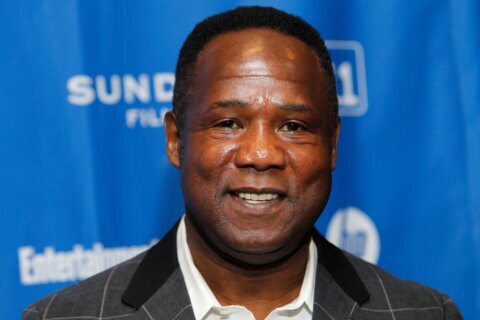WASHINGTON — It was exactly 20 years ago on this date that television changed forever. HBO’s “The Sopranos” premiered on Jan. 10, 1999, a watershed moment that, along with its siblings “Oz” and “Sex and the City,” shifted viewers from network TV to must-see cable hits.
It’s easy to take for granted now, but the idea of waiting a full week for an hourlong, cinema-quality series was revolutionary. Before “The Sopranos” (1999-2007), network TV won the Emmy for Best Drama every year on NBC (“The West Wing,” “ER,” Law & Order”), ABC (“The Practice,” “NYPD Blue,” “Lost”) or FOX (“24”). After “The Sopranos,” the networks haven’t won since, instead going to cable and streaming channels, such as AMC (“Mad Men,” “Breaking Bad”), Showtime (“Homeland”), HBO (“Game of Thrones”) and Hulu (“The Handmaid’s Tale”).
In other words, Tony Soprano came along and whacked the entire network TV model. But beyond its legacy as a pioneer, which specific ingredients make it an all-time classic? And what exactly happened in the controversial “cut to black” in the series finale? Time for a deep dive:
The Premise
Imagine Michael Corleone seeing a shrink to vent his guilt over mob hits. That was the genius premise by creator David Chase to juxtapose bloody mafia murders with regular suburban life. This dichotomy was epitomized in the Season 1 episode “College” as Tony strangled a rat during a campus tour with daughter Meadow. How unique to see a character spill blood on the streets, then spill emotions to his therapist. The moral dilemma of doctor-patient privilege was never more delicious, as we wondered how long Dr. Melfi should keep Tony’s secrets.
The Writing
Stemming from this brilliant concept, the screenwriting in each episode was as good as it gets, voted by the Writers Guild of America as the Best Written Television Show of All Time ahead of “Seinfeld,” “The Twilight Zone,” “All in the Family,” “M*A*S*H” and “The Mary Tyler Moore Show.” Head writers Terence Winter and Matthew Weiner went on to create “Boardwalk Empire” and “Mad Men,” respectively, while recurring director Tim Van Patten went on to helm episodes of “The Wire,” “Deadwood,” “Rome,” “Game of Thrones” and “Black Mirror.”
The Cast
All the writing in the world wouldn’t mean a thing without the proper human vessels. Enter the late James Gandolfini as the brutish Tony and future “Nurse Jackie” star Edie Falco as no-nonsense wife Carmela. Their on-screen argument in the episode “Whitecaps” is an acting masterclass, planting the seeds of Don and Betty Draper’s infidelity implosion, Walter and Skyler White’s drug-dealing debates and Frank and Claire Underwood’s political posturing.
Surrounding them is a slew of familiar faces. Dominic Chianese followed his role as Johnny Ola in “The Godfather: Part II” by playing Uncle Junior across a gang of “Goodfellas” alums in Lorraine Bracco as Dr. Melfi, Michael Imperiolli as Christopher Moltisanti, Frank Vincent as Phil Leotardo and Tony Sirico as Paulie Walnuts. We also saw E Street Band mate Steven Van Zandt as Silvio Dante, Drea de Matteo as Adriana, Robert Iler as A.J. and Jamie-Lynn Sigler as Meadow. Even Julianna Margulies parlayed a bit part into the lead role of “The Good Wife.”
The Shock Value
We became so attached to these characters that each season offered stunning moments of peril. Season 1 saw Tony nearly smother his own mother in a nursing home in “I Dream of Jeannie Cusamano.” Season 2 saw Tony’s sister Janice gun down Richie in “The Knight in White Satin Armor” and Big Pussy sleep with the fishes in “Funhouse.” Season 3 saw Christopher and Paulie chase a Russian gangster through the snowy woods in the Steve Buscemi-directed “Pine Barrens.” And Season 4 saw Ralphie’s head in a bowling bag in “Whoever Did This.”
Season 5 saw a shotgun send Buscemi flying into firewood in “All Due Respect” and Adriana’s heartbreaking demise in “Long Term Parking.” Season 6 put Tony in a coma for trippy dream sequences in “Join the Club” and Bobby derailed on toy train tracks in “The Blue Comet.” And Season 7 saw Christopher’s car accident in “Kennedy and Heidi” and A.J.’s botched suicide attempt in “The Second Coming,” fittingly cutting his rope too short to drown in the pool.
The Soundtrack
Each of these episodes opened with the unforgettable title theme, “Woke Up This Morning,” with Alabama 3 gruffly crooning the refrain “got yourself a gun.” It was the perfect sinister track for the opening credits, which serendipitously showed the Twin Towers disappear in the rearview mirror during Tony’s drive home on the Jersey Turnpike into a suburban driveway.
Even within the episodes, Chase chose a number of soundtrack selections with symbolic lyrics, including The Kinks’ “Living on a Thin Line” at the Bada Bing strip club (“All the stories have been told of kings and days of old”), Pink Floyd’s “Comfortably Numb” during Tony farewell to Christopher (“the child is grown, the dream is gone”) and Journey’s “Don’t Stop Believin'” on the series finale jukebox (“paying anything to roll the dice just one more time”).
The Finale
This controversial finale triggered a collective panic attack, causing viewers to fear their cable feeds had cut out and sending couch potatoes to Dr. Melfi’s therapist couch to cope. While “Dallas” famously revealed who shot J.R. Ewing, “The Sopranos” offered no such closure. This was no cliffhanger; this was an artistic stroke of finality. Thus, the debate remains to this day.
In 2014, Vox asked Chase point blank whether Tony is dead, to which he reportedly replied, “No, he isn’t.” Chase’s reps pushed back: “There is a much larger context for that statement and as such, it is not true. As David Chase has said numerous times on the record, ‘Whether Tony Soprano is alive or dead is not the point.’ To continue to search for this answer is fruitless. The final scene … raises a spiritual question that has no right or wrong answer.”
To me, it’s pretty clear that Tony is whacked. Yes, we never see him physically shot, we never hear gunfire and we never even see a gun. But the evidence is all there if you look closely:
1) At the start of the final season, Tony chats with brother-in-law Bobby in a Fredo-style boat. They discuss what it’s like to be whacked: “You probably don’t even hear it when it happens.”
2) Tony enters a coma in the final season premiere, “Members Only,” foreshadowing Tony’s eventual killer, who’s listed in the credits of the finale as “Man in the Members Only Jacket.”
3) While in the coma, Tony enters purgatory at the heavenly Inn at the Oaks estate. Here, Tony’s dead mother waits in the doorway in silhouette; Buscemi tries to take his briefcase (i.e. his soul) and Meadow’s voice calls out from the woods, “Don’t go, Daddy!” You’ll notice that this estate even resembles the painting on the rear wall of the restaurant during the finale.
4) Everyone remembers “Don’t Stop Believin’” playing on the restaurant jukebox, but pay close attention to the lyrics. Note how the lyrics “just a small town girl” play over a shot of Carmela, while “just a city boy” play over a shot of Tony. If Chase is careful enough to time these lyrics, it stands to reason that he would also match the lyrics of the killer, who enters the restaurant to the lyrics, “Strangers waiting up and down the boulevard.” Waiting to kill.
5) Tony studies each patron with extreme paranoia — except for his killer. He’s distracted because the Man in the Member’s Only Jacket enters at the same time as A.J. How beautifully ironic that this corrupt family man is distracted by the love for his son in his final moments.
6) Upon sitting at the table, A.J. reminds Tony of something he once said: “Focus on the good times.” This line is spoken just as the killer sits “out of focus” in the background at the bar.
7) As the gunman gets up from the bar, we cut to a very deliberate pan showing him enter the bathroom to “hiding somewhere in the night.” Our pop-culture memory reminds us that Al Pacino grabbed a gun from the bathroom to whack a mob boss in “The Godfather.” Similarly, one of the show’s dream sequences showed Tony grab a gun in a restaurant bathroom.
8) As the family chows down on onion rings, the circular shape of the food symbolizes bullet holes: one bullet for Tony, one for Carmela and one for A.J. Why not just have Tony order french fries? It has to be rings, just as Warren Beatty shot the rings in “Bonnie and Clyde.” Or, perhaps they’ll be resurrected, eating the onion rings like Catholic Church communion wafers.
9) Tony’s daughter, Meadow, is spared because she’s late to arrive, struggling to parallel park just like in the show’s early seasons. The restaurant geography suggests Meadow should have been sitting next to Tony in the gunman’s path from the bathroom. Instead, she arrives late and tragically watches her own father’s murder, as the screen cuts to black just as she enters.
10) Finally, each time the doorbell rings, we get two shots: (a) an objective shot of Tony looking up, followed by (b) a subjective shot from Tony’s point of view. According to this pattern, the screen cuts to black within Tony’s P.O.V., suggesting that he is in fact dead.
Behold — the moment that the cinematic shot became a shot.
The above clues are enough to conclude that Tony is whacked. Still, if you’re looking for hope, Chase’s favorite poem is Edgar Allan Poe’s “A Dream Within a Dream” (“Is all we see or seem but a dream within a dream?”). As Tony enters, we hear, Little Feat’s “All That You Dream.” As he stares across the room at the empty table, we hear, “Clouds change the scene.” It’s at this precise point that Tony sees himself sitting across the room, entering his own P.O.V. in a jarring cut reminiscent of Kubrick’s transcendent finale of “2001: A Space Odyssey” (1968).
Tony is no longer in reality. He’s watching a vision of himself. The dream theory doesn’t rule out the life or death theories; it expands upon them. After all, we don’t know if Tony wakes up in a cold sweat or if he’s fated to live out this ominous premonition. It’s layers upon layers.
Taking it a step further with Poe’s poem in mind, maybe we’ve all been here before and life is a recurring set of “Dreams Within Dreams.” Just as Dr. Melfi danced in “Goodfellas” to the lyrics, “Life is but a dream, it’s what you make it,” the “Sopranos” finale is truly “Any Way You Want It,” which just happens to be the jukebox B-side of “Don’t Stop Believin’” on screen.
For all of this, we see the true genius of its masterful creator, who demonstrates a degree of visual storytelling that is rare for movies, let alone television. Chase deserves to go down in history as an equal to 2007 peers Paul Thomas Anderson and the Coen Brothers, who offered their own abrupt “cuts to black” in “There Will Be Blood” and “No Country for Old Men.”
Regardless of whether you loved or hated the “Sopranos” finale initially, repeat viewings prove that it is one of the most masterfully constructed scenes in entertainment history. As he cuts to black, Chase signs his masterpiece with a line that captures our longing for it: “Don’t stop.”
And yet, we’re still talking about it. The movie never ends. It goes on and on and on and on.







